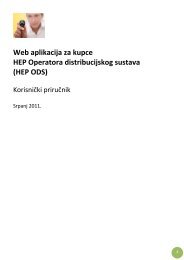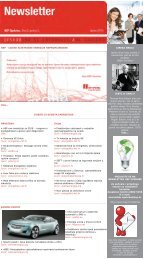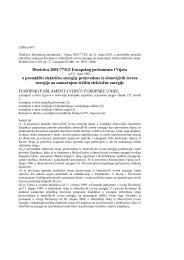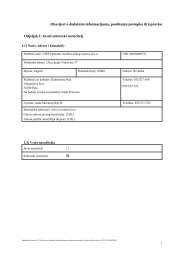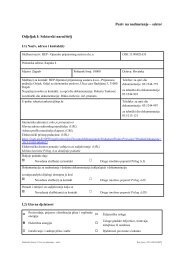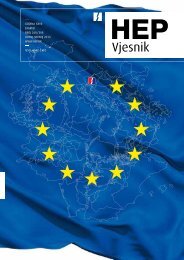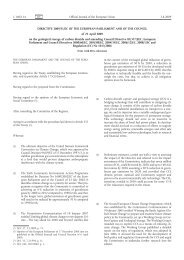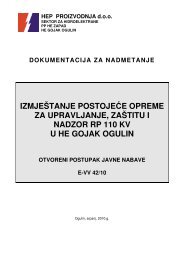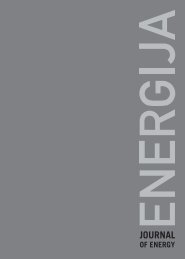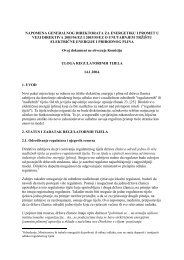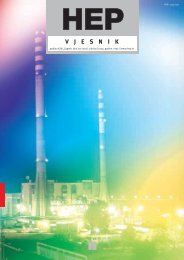Untitled
Untitled
Untitled
You also want an ePaper? Increase the reach of your titles
YUMPU automatically turns print PDFs into web optimized ePapers that Google loves.
P max (t - 1) ∑ gornja granica dozvoljenog prihoda ugodini t -1,CPI t ∑ indeks potroπaËkih cijena u godini t,X t ∑ faktor uËinkovitosti u godini t,KP t ∑ faktor korekcije u godini t.Mehanizam poticajne regulacije prije svega nastojikroz poticaje (X-faktor) poveÊati uËinkovitost energetskihsubjekta. Pri tome vrijedi pretpostavka daje energetski subjekt u stanju kontrolirati razinusvojih troπkova. Za troπkove za koje se smatra daih energetski subjekt ne moæe kontrolirati, odnosnoda su izvan kontrole subjekta, kao πto su tonpr. porezi, naknada za regulaciju, troπkovi kojeje prouzroËila viπa sila i sl., ne moæe se oËekivatipoveÊanje uËinkovitosti subjekta na raËun njihovogsmanjenja. Stoga se poticaji primjenjuju narazinu kontroliranih troπkova, dok se nekontroliranitroπkovi smatraju prolaznim i u cjelokupnomiznosu se prebacuju na kupca. Detaljna elaboracijagranice izmeappleu kontroliranih i nekontroliranihtroπkova zahtijeva dublje analize od straneregulatornog tijela. Kao primjer troπkova koji semogu svesti u sferu kontroliranih i nekontroliranihtroπkova su troπkovi tehniËkih gubitaka u mreæi.Ukoliko regulatorno tijelo smatra da su gubici upotpunosti nekontrolirani troπak, prihvaÊa njihovurazinu, odnosno njihov troπak, u iznosu koji prijavljujeenergetski subjekt. U tom sluËaju energetskisubjekt neÊe imati nikakav poticaj da ih smanji,bilo u vidu troπka bilo u vidu fiziËkih gubitakaizraæenih u kWh. Meappleutim, ukoliko ih regulatornotijelo smatra kontroliranim troπkom, nastojat Êe ihkroz regulatornu politiku svesti u granice koje sesa stajaliπta regulatornog tijela Ëine opravdanima.Kada se radi o kontroliranim troπkovima, regulatornapolitika razlikuje dvije grupe troπkova:∑∑operativne troπkove (engl. Operating Expanditures∑ OPEX), troπkovi koje je moguÊe kontroliratiu kratkoroËnom razdoblju ikapitalne troπkove (engl. Capital Expanditures∑ CAPEX), troπkove koje je moguÊe kontroliratiu dugoroËnom razdoblju.U OPEX se ubrajaju troπkovi osoblja, materijalnitroπkovi, troπkovi odræavanja, ostali troπkovi poslovanjai sl. Troπkovi koje je moguÊe prilagoappleavati urelativno kratkom roku. S druge pak strane, CA-PEX se u kratkoroËnom razdoblju moæe promatratikao fiksni troπak buduÊi da se i prvenstveno radio troπkovima koji se veæu uz investicije u razvojmreæa i poboljπanje kvalitete opskrbe. CAPEX jemoguÊe podijeliti u dvije grupe ∑ amortizaciju ipovrat sredstava koji se definira kao godiπnja stopapovrata primijenjena na neamortizirani dio ulaganja.Povrat sredstava u naËelu utvrappleuje regulator-R max (t -1) ∑ the upper limit of revenue, i.e. revenuecap,in year t -1,CPI t ∑ the consumer price index in year t,X t ∑ the efficiency factor in year t,KP t ∑ the correction factor in year t.The mechanism of incentive regulation primarily attemptsto increase the efficiency of energy entitiesthrough incentives (the X-factor). It is presumed thatan energy entity is in a position to control the levelof its expenditures. For expenditures presumed tobe non-controllable by an energy entity, i.e. that areout of the control of the entity, such as, for example,taxes, regulation charges, expenditures due to forcemajeure etc., it is not possible to expect that theentity will achieve increased efficiency by reducingthem. Therefore, incentives are applied at the levelof controllable costs, while non-controllable costsare considered to be transitory and are transferredin their entirety to the customers. A detailed elaborationof the boundary between controllable and noncontrollableexpenditures requires in-depth analysisby the regulatory body. An example of expendituresthat can be classified within the spheres of both controllableand non-controllable expenditures are thecosts of technical losses in the network. Insofar asthe regulatory body considers the losses to be entirelynon-controllable expenditures, it accepts their level,i.e. their cost, in the amount that the energy entityreports. In this case, the energy entity will not haveany incentive to reduce them, whether in the aspectof expenditures or the aspect of physical losses expressedin kWh. However, insofar as the regulatorybody considers them to be controllable expenditures,it will attempt to lower them through regulatory policyto within the limits considered justified from thestandpoint of the regulatory body.Concerning controllable expenditures, regulatorypolicy differentiates between two groups ofexpenditures:∑∑Operating expenditure ∑ OPEX, expenditure thatcan be controlled within a short-term periodCapital expenditure ∑ CAPEX, expenditure thatcan be controlled within a long-term period.Under OPEX are included personnel costs, materialcosts, maintenance costs, other operating costs etc.These are expenditures that can be adjusted withina relatively short period. On the other hand, CAPEXcan be considered as fixed expenditures within ashort-term period, primarily concerning expendituresin connection with investment in networkdevelopment and improvement in the quality of thesupply. CAPEX can be divided into two groups ∑depreciation and return on assets, defined as theannual rate of return applied to the non-depreciatedportion of investment. In principle, the returnŠtritof, I., KleËina, F., Regulatorna politika i njen utjecaj ..., Energija, god. 56(2007), br. 5., str. 554-583Štritof, I., KleËina, F., Regulatory Polica and Its Impact ..., Energija, vol. 56(2007), No. 5, pp. 554-583564



